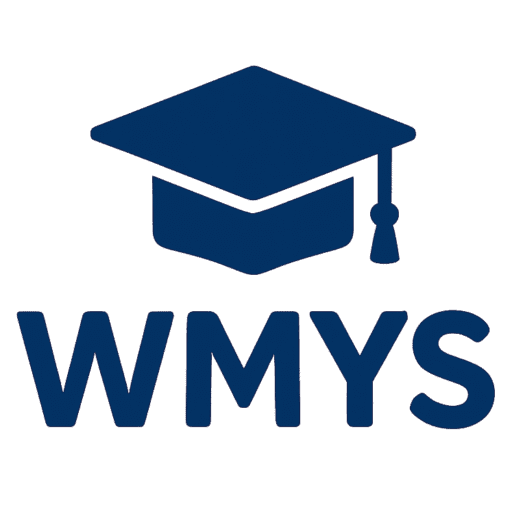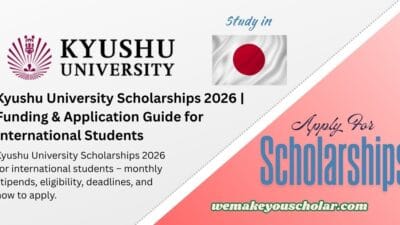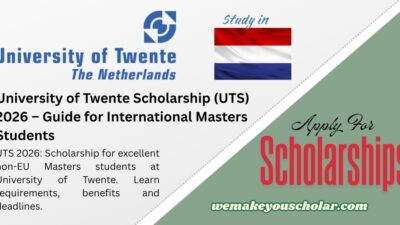Hokkaido University (Graduate School of Environmental Science) — Scholarships & Fellowships 2026 (International Students)
This post is a clean, student-focused guide to scholarships and fellowships available to international master’s and doctoral applicants at Hokkaido University, especially within the Graduate School of Environmental Science (EES). It combines key facts about MEXT (University Recommendation), EES doctoral fellowships (EXEX, Next-Gen AI), university grants, eligibility, application steps, deadlines for 2025–2026 intakes, and practical tips — all in one place.
Quick Snapshot — What You Should Know Right Now
- Target audience: International students applying for Master’s (Oct/Apr intake) and Doctoral programs (Oct/Apr intake) at Hokkaido University (EES).
- Major funding lines: MEXT (University Recommendation), EES Doctoral Fellowships (EXEX, Next-Gen AI), Hokkaido University internal grants and special tuition waivers.
- Typical stipend (MEXT): ~¥144,000/month (Master’s) and ¥145,000/month (PhD).
- Application windows: Multiple entrance exams are held; key application periods for April 2026 admission include mid-2025 windows and late 2025 / early 2026 windows. See official links below.
- Start dates: October 2025 (Autumn intake) and April 2026 (Spring intake).
Why Choose Hokkaido University (EES)?
Hokkaido University is one of Japan’s leading research universities. The EES focuses on environmental science, Earth system science, biosphere science, and environmental materials. Key benefits for international students include:
- Strong research groups and laboratories in environmental and earth sciences.
- Programs and supervision available in English in many divisions.
- Access to targeted doctoral fellowships that include living stipends and research support.
- Opportunities to apply for the national MEXT scholarship via university recommendation.
Major Scholarship & Fellowship Types (Overview)
MEXT Scholarship — University Recommendation (Hokkaido University)
The Japanese Government (MEXT) scholarship via university recommendation is a flagship funding route. Hokkaido University nominates a small number of qualified international applicants for MEXT; successful nominees receive comprehensive support:
- Monthly stipend (Master’s: ~¥144,000; Doctoral: ~¥145,000).
- Tuition and admission fee exemption.
- Round-trip travel allowance in many cases.
- Full scholarship duration: typical Master’s = 2 years; Doctoral = 3 years (per MEXT rules).
Important: MEXT nominations usually require the consent of a prospective supervisor and submission through the university (supervisor & department). Deadlines and quotas are strict — follow the Graduate School instructions and contact prospective supervisors early.
EES Doctoral Fellowships (EXEX, Next-Gen AI, etc.)
EES and related faculties run internal doctoral fellowship programs to support research and living costs. Two examples:
- EXEX Doctoral Fellowship — supports high-potential doctoral researchers in environmental science topics.
- Next Generation AI Doctoral Fellowship — targets doctoral candidates working at the intersection of AI and environmental science.
These fellowships vary by duration and value but typically include monthly support and research allowances. Eligibility usually requires admission to a PhD program and alignment with a supervisor’s funded research.
University Internal Grants & Tuition Waivers
Hokkaido University offers various internal grants, including tuition waivers for self-funded students, faculty-level support, travel grants for conferences, and short-term fellowships. Some departments advertise specific funds for international students; check your department’s page and contact the graduate office.
Eligibility — Who Can Apply for These Funding Lines?
Eligibility varies by scholarship. Common requirements include:
- Non-Japanese nationality (international applicant).
- Holding or expecting a relevant prior degree (Bachelor for Master’s; Master for PhD applicants, unless exceptions apply).
- Strong academic record and research potential.
- For MEXT university recommendation: prospective supervisor’s endorsement and university nomination.
- Language requirements: many EES programs accept English-taught applications; some programs request Japanese proficiency for fieldwork or teaching duties.
Application Timeline & Key Dates (Summary)
Hokkaido University runs different entrance exams throughout the academic year. Below are the main examination types relevant for 2025–2026 admissions (check official pages for exact dates each year):
- Fall Entrance Examination (for April 2026 admission): Application period July 4–14, 2025; exam Aug 20–21, 2025.
- Spring Entrance Examination (for April 2026 admission): Application Jan 7–15, 2026; exam Feb 18–19, 2026.
- Entrance Examination for October 2025 admission: Separate schedule — often mid/late 2025.
- Special Selected Candidate Exams: For some master’s courses with unique windows (check department pages).
Tip: If you’re targeting MEXT university recommendation, coordinate with your prospective supervisor well before the internal nomination deadlines (often in late autumn/early winter).
Step-by-Step Application Guide (Student Checklist)
1. Research and Choose a Programme
Identify the right division within EES (Earth System Science, Biosphere Science, Environmental Materials Science, or Environmental Science Development). Review course details, faculty research interests, and lab pages.
2. Contact Potential Supervisors Early
Find 1–3 faculty members whose research aligns with your interests. Email them concise, personalised messages including your CV, transcript, and a brief research idea. For MEXT nominations, supervisor commitment is essential.
3. Prepare Application Documents
- Academic transcripts and degree certificates (translated if necessary).
- Research proposal or statement of purpose (clear aims, methods, and timeline).
- Curriculum Vitae (CV) with research experience, publications, and references.
- Recommendation letters (usually two academic references).
- Proof of language proficiency (TOEFL/IELTS or Medium of Instruction certificate).
4. Apply for Admission & Scholarship
Submit your graduate application through Hokkaido University’s application portal or as instructed by EES. For MEXT university recommendation, follow the department’s internal nomination process — often via the prospective supervisor.
5. Prepare for Entrance Examinations & Interviews
Entrance tests may include written exams, English proficiency checks, and interviews (online or on campus). Practice explaining your research clearly and be ready to discuss methods and motivation.
6. After Admission — Scholarship Formalities
If nominated for MEXT or selected for internal fellowships, follow the university’s instructions for document submission, visa paperwork, and pre-arrival procedures.
What the Funding Usually Covers — Practical Breakdown
- Stipend: MEXT cotters ~¥144,000–¥145,000/month for living costs.
- Tuition & fees: Exempted for many MEXT and some internal grants.
- Travel: Round-trip airfare may be provided under MEXT (check specific terms).
- Research costs: Small annual study allowance for books, materials, and conference travel (varies by fellowship).
Practical Tips for International Applicants
- Start early: Faculty contact, supervisor consent, and document preparation take time.
- Tailor your research proposal: Show clear alignment with supervisor’s work and Hokkaido’s research strengths.
- Highlight fieldwork readiness: For environmental sciences, mention any relevant field, lab skills, or equipment familiarity.
- English evidence: If your degree was in English, request a Medium of Instruction letter to avoid retaking tests.
- Visa & living: Budget for initial months before stipend disbursement; arrange housing and health insurance early.
Selection Criteria — What Reviewers Look For
- Academic excellence and research potential.
- Feasibility and clarity of the proposed research project.
- Fit with the supervisor’s research group and departmental priorities.
- Motivation, communication skills, and ability to work independently.
Frequently Asked Questions (FAQs)
Q1: Do I need to know Japanese to apply?
No — many EES programs and research groups accept applications in English. However, basic Japanese helps daily life and some fieldwork or administrative tasks.
Q2: Can I apply for MEXT if I’m already in Japan?
Yes — many MEXT applicants are already in Japan. Check eligibility and application pathways with your prospective supervisor and the international office.
Q3: How many MEXT slots are available at Hokkaido University?
Slots are limited and vary by department and year. For some programs (e.g., select life sciences tracks), only a few MEXT nominations are available (e.g., 3 master’s and 4 doctoral in certain calls). Early contact with supervisors is crucial.
Q4: What are common mistakes applicants make?
- Contacting supervisors too late or with generic emails.
- Submitting unclear or unrealistic research proposals.
- Missing department-specific internal nomination deadlines for MEXT.
- Not verifying document translation or notarisation requirements.
Q5: Where can I find official, up-to-date information?
Always use the official Hokkaido University EES pages and the university’s global admissions pages. Key links are included below.
Official Links & Resources (Bookmark These)
- Hokkaido University — Graduate School of Environmental Science (EES) Admissions
- Hokkaido University — Scholarships for Prospective Students
- Life Science IGP — MEXT Special Quota (example page)
- Japan Study Support / Study in Japan (general scholarship portal)
Note: Scholarship availability, stipend amounts, and deadlines can change yearly. Always confirm final details on the official pages above or through direct contact with the EES admissions office or your prospective supervisor.




